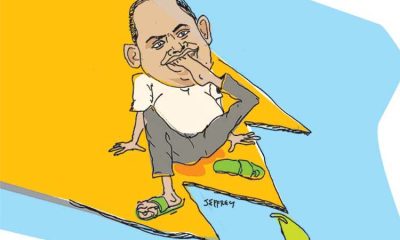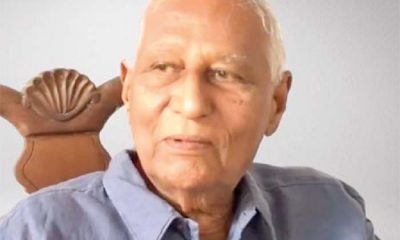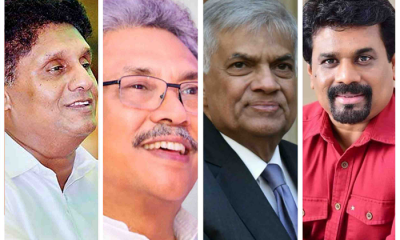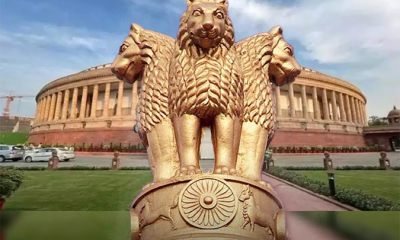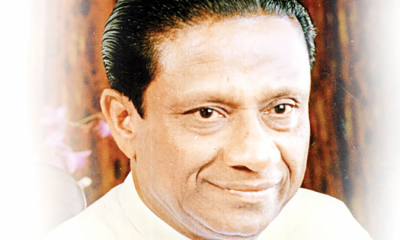Features
Revival of Premadasaism: Way forward for Sri Lanka
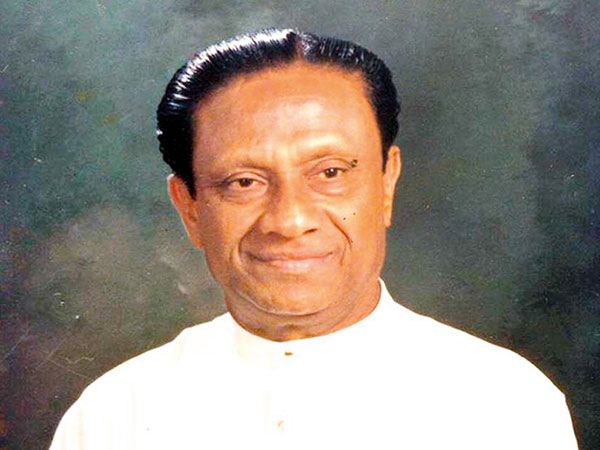
By Dr. Mahim Mendis
Sri Lanka President’s Scholar, British Chevening Scholar, National University of Singapore Scholar and US State Department Post Doctoral Scholar
I was socialised in my childhood by an ardent Samasamajist father in Moratuwa. However, I became disillusioned in my youth, as I witnessed the ground level actions of the Samasamaja Party, working with Feudalists who pretended to be progressive.
I was not surprised when the LSSP was rejected by voters in the 1977 election. The void created in me was filled by Vijaya Kumaranatunge, when he formed the Mahajana Party with a principled position on social justice. When the JVP brutally murdered Vijaya in 1987, my hopes were dashed.
By the time I entered Kelaniya University, I was becoming a convert to ‘Premadasaism’ – the deep convictions found in the words and deeds of Ranasinghe Premadasa that I diligently followed.
I was mesmerised by the speeches of Premadasa, who articulated his pro-poor ideology of the UNP, the party, that my father opposed all his life. Today, I am convinced that Sri Lanka is fortunate that Premadasa has left for this nation a son named Sajith, who is inspired by Premadasa’s ideology and his simple lifestyle.
Pragmatic and Practical
While academics continue to talk about grand development theory, Ranasinghe Premadasa spent his life evolving a truly Sri Lankan development model to ensure and enable common people to reach excellence in all sectors of human development.
Youth of the land should not forget that Premadasa had the foresight to build the first ever, Day and Night Cricket Stadium, at Kettarama, long before we won the World Cup in 1996 and transformed Sugathadasa Stadium in line with top international benchmarks, encouraging younger athletes to reach excellence at the Olympics. He believed that Damayanthi Darsha, the South Asian Games Gold medalist should access the best schools of the land, paving the way for her to be educated at Ladies College, Colombo. He was impatient to see the bright rural youth shine unlike feudal politicians who preached one thing to the people and practiced another for their own children.
To serve the needs of common people, he established the Sevana Sarana Foster Parents scheme, to provide for the material needs of children. For this he mobilised the affluent to be socially sensitive to the bright, but poor children.
Today, it is not surprising to see his son Sajith inspired to do all this even before he forms a government.
Birth of Premadasaism
Premadasa harboured these grand ideals of Pro-People Development when he was a child of 15 years of age. He established the Sucharitha Movement in his own habitat Keselwatta, in the Colombo Central electorate.
Premadasa’s vision was far beyond Marxism of Kueneman or Communist Trade Unionism of L. W Panditha and the Temperance policies of F.R. Senanayake. He saw the beauty of holistic human development, balancing physical and material self-sufficiency of people with spiritual, emotional, and cultural self-sufficiency. He knew clearly that building a ‘Total Man’, would contribute towards a holistic ‘Total Society.’
As a social worker at the early age of fifteen, he celebrated the First Anniversary of the Sucharitha Movement with S. W. R. D. Bandaranaike and Mrs. Bandaranaike as Chief Guests, long before Bandaranaike ever thought of forming the SLFP.
Having entered politics in his youth under the tutelage of the eminent Labour leader A. E. Goonesinghe, Premadasa realised just as his political guru Goonesinghe realised, that Marxist inspired politicians coming from affluent backgrounds had severe limitations in their capacities as they were overwhelmed by their own unparalleled revolutionary rhetoric that made them lag in actions.
Premadasa would turn in his grave if he heard the emotionally and spiritually sterile NPP/Marxist rhetoric of today that husbands should remunerate their wives for their domestic labour.
Communicating Revolutionary Ideas in a Language Common Man Understood
Premadasa soon became the Youth Front Leader of AE Gunasinghe’s Labour Party and was able to explain about social emancipation to the common people- what Marxists like Peter Kuenemann in Central Colombo or Dr. N. M Perera of Ruwanwella could not explain in lingo understood by the poor.
When Premadasa opted to join the UNP, its leader Dudley Senanayake had the wisdom to appreciate this capacity, pitting young Premadasa against Dr. N. M Perera in Dr. Perera’s own electorate Ruwanwella, at the 1956 Parliamentary elections.
The election proved that the Marxist giant Dr. Perera could defeat young Premadasa, only by a margin of mere 6,228 votes.
Ironically ten years later, Dr Peter Kueneman, Dr. Colvin R. De Silva, Dr. S. A. Wickramasinghe and the other LSSP and Communist Party Parliamentary stalwarts had to retire from Parliamentary politics when they were politically annihilated by the UNP campaign that was led by the same Premadasa who was Deputy Leader of the UNP at the 1977 Parliamentary elections.
Humility of Premadasa and Arrogance of Distractors
President Premadasa was an extraordinary leader with a broad imagination. He was prepared to embrace Oxford educated Susil Siriwardena, a former Theoretician of the JVP, and listen to Wijeweera, attending conscientiously the proceedings of the Criminal Justice Commission in the aftermath of the First JVP uprising in 1971.
He extended his hand of friendship to them with conviction. However, Wijeweera was not prepared. Susil, who was a JVP theoretician, was wiser in correctly perceiving the mind of Premadasa.
The difference between Premadasa and Wijeweera, as my respected friend Dr. Dayan Jayatilleke makes clear is that unlike Wijeweera, Premadasa saw no place for violence in social system change as violence would have to be suppressed by the State at a severe cost to the very people whom they tried to emancipate. Ironically, JVP failed to appreciate this, due to arrogance on their part as stated by Dr. Jayatilleke in a recent interview with Kusum Wijetilleke- a trait that they still have not shed due to the inherent tendency to overestimate themselves.
In the late 1980’s, Premadasa appointed the National Commission on Youth Unrest, chaired by Professor G. L. Peiris, who made serious recommendations such as meritocracy, based employment and youth participation in politics.
Professor Peiris, who was appointed Vice Chancellor of Colombo University by President Premadasa, and Founder Chair of Pohottuwa, recently opted to join with Sajith Premadasa as he was convinced that Sajith.
Premadasa’s as a Champion of Inclusive Development
The 1978 Constitution purposefully alienated anti-establishment as well as ethnic minority parties from being represented in parliament. For this, JR Jayewardene’s Constitution had a purposeful, but unrealistic cut off point of 12 % in electoral performance for representation.
The present-day JVP should appreciate that Premadasa not only released more than 1,000 JVP activists when he came to power but brought down the cut off point for representation to 5%. Today, the JVP is represented in parliament, together with ethnic minority parties which continue to advocate shared political power.
While progressive Sri Lankans appreciate these social democratic political reforms, the very beneficiaries of these policies may not appreciate what Premadasa achieved for them with his powerful ethos of inclusive, value centered development for the common good of all Sri Lankans. However, many people will remember him as a genuine seeker of a new Social Contract.
Knowing Difference Between Extreme Capitalism and Extreme Socialism
Truly, cultured men and women have the capacity to be thankful for the progressive measures taken by Ranasinghe Premadasa. He was a true embodiment of social democracy, governing the entire social, political, cultural, and moral order. He was not a mere propagator of a social market economy, when he took over leadership from a right wing, J.R. Jayewardene led the UNP that tried to deprive Deputy Leader Premadasa of his well-earned presidential candidature in 1989. The same right-wing forces in the UNP, tried to impeach him together with Feudalist sympathizers, who lost all their social status due to Premadasaism
Cost of Disowning Premadasa Programme and Vision
Ironically, the so-called educated people of the land, who were found guilty of bankrupting the Sri Lankan economy are among those who disowned the Premadasa legacy that brought recognition, human dignity, and prosperity to our people.
As emphasised by world renowned social scientist, Dr. Howard Nicholas in an interview with Kusum Wijetilleke, his pessimism about Sri Lanka, turned into great optimism in late 1980s with the pro-people contribution of Ranasinghe Premadasa. This, as he says, was a time Sri Lanka was in a perilous condition with a total breakdown of institutions, aggravated by JVP and LTTE terrorism.
Promise for the Future: The Need for a Likeminded Leader
We need a visionary leader with the right mindset with a heart for the poor and for those who can generate wealth and transform Sri Lanka. We know that the options are very few. The heart and the mind of Premadasa is what is absent in the very people that Premadasa groomed for leadership, including the current President, Ranil Wickramasinghe.
Today, the only hope we see for our nation is Sajth Premadasa; Premadasa’s son who has the courage and foresight to commence an unprecedented Social Democratic programme.
Ranasinghe Premadasa, expounding his grand development vision as far back as 04 April, 1973, stated:
“Political power has been diffused amongst the people through the exercise of the franchise. In like manner, the economic wealth of the country should also be diffused amongst the people. We should evolve a scheme under which the public sector, the co-operative sector, the private sector, and a combination of all these three sectors – a joint sector – could function in competition with each other. Such competition will bring the maximum benefit to the people who need not become slaves of either a public or private monopoly. The government should ensure through its legislative and planning processes that the people participate in all aspects of development without allowing monopolies — state or individual.”
As a petitioner of the historic Supreme Court Case, in 2022, on bankrupting of the economy, which led to a historic verdict in favour of our petition, I would not have been moved to file action on behalf of the country’s entire citizenry, if not for my respect for the Premadasa ideology, which is continued and adapted to meet the challenges of modern Sri Lanka by his son, Sajith Premadasa.
Features
The heart-friendly health minister

by Dr Gotabhya Ranasinghe
Senior Consultant Cardiologist
National Hospital Sri Lanka
When we sought a meeting with Hon Dr. Ramesh Pathirana, Minister of Health, he graciously cleared his busy schedule to accommodate us. Renowned for his attentive listening and deep understanding, Minister Pathirana is dedicated to advancing the health sector. His openness and transparency exemplify the qualities of an exemplary politician and minister.
Dr. Palitha Mahipala, the current Health Secretary, demonstrates both commendable enthusiasm and unwavering support. This combination of attributes makes him a highly compatible colleague for the esteemed Minister of Health.
Our discussion centered on a project that has been in the works for the past 30 years, one that no other minister had managed to advance.
Minister Pathirana, however, recognized the project’s significance and its potential to revolutionize care for heart patients.
The project involves the construction of a state-of-the-art facility at the premises of the National Hospital Colombo. The project’s location within the premises of the National Hospital underscores its importance and relevance to the healthcare infrastructure of the nation.
This facility will include a cardiology building and a tertiary care center, equipped with the latest technology to handle and treat all types of heart-related conditions and surgeries.
Securing funding was a major milestone for this initiative. Minister Pathirana successfully obtained approval for a $40 billion loan from the Asian Development Bank. With the funding in place, the foundation stone is scheduled to be laid in September this year, and construction will begin in January 2025.
This project guarantees a consistent and uninterrupted supply of stents and related medications for heart patients. As a result, patients will have timely access to essential medical supplies during their treatment and recovery. By securing these critical resources, the project aims to enhance patient outcomes, minimize treatment delays, and maintain the highest standards of cardiac care.
Upon its fruition, this monumental building will serve as a beacon of hope and healing, symbolizing the unwavering dedication to improving patient outcomes and fostering a healthier society.We anticipate a future marked by significant progress and positive outcomes in Sri Lanka’s cardiovascular treatment landscape within the foreseeable timeframe.
Features
A LOVING TRIBUTE TO JESUIT FR. ALOYSIUS PIERIS ON HIS 90th BIRTHDAY

by Fr. Emmanuel Fernando, OMI
Jesuit Fr. Aloysius Pieris (affectionately called Fr. Aloy) celebrated his 90th birthday on April 9, 2024 and I, as the editor of our Oblate Journal, THE MISSIONARY OBLATE had gone to press by that time. Immediately I decided to publish an article, appreciating the untiring selfless services he continues to offer for inter-Faith dialogue, the renewal of the Catholic Church, his concern for the poor and the suffering Sri Lankan masses and to me, the present writer.
It was in 1988, when I was appointed Director of the Oblate Scholastics at Ampitiya by the then Oblate Provincial Fr. Anselm Silva, that I came to know Fr. Aloy more closely. Knowing well his expertise in matters spiritual, theological, Indological and pastoral, and with the collaborative spirit of my companion-formators, our Oblate Scholastics were sent to Tulana, the Research and Encounter Centre, Kelaniya, of which he is the Founder-Director, for ‘exposure-programmes’ on matters spiritual, biblical, theological and pastoral. Some of these dimensions according to my view and that of my companion-formators, were not available at the National Seminary, Ampitiya.
Ever since that time, our Oblate formators/ accompaniers at the Oblate Scholasticate, Ampitiya , have continued to send our Oblate Scholastics to Tulana Centre for deepening their insights and convictions regarding matters needed to serve the people in today’s context. Fr. Aloy also had tried very enthusiastically with the Oblate team headed by Frs. Oswald Firth and Clement Waidyasekara to begin a Theologate, directed by the Religious Congregations in Sri Lanka, for the contextual formation/ accompaniment of their members. It should very well be a desired goal of the Leaders / Provincials of the Religious Congregations.
Besides being a formator/accompanier at the Oblate Scholasticate, I was entrusted also with the task of editing and publishing our Oblate journal, ‘The Missionary Oblate’. To maintain the quality of the journal I continue to depend on Fr. Aloy for his thought-provoking and stimulating articles on Biblical Spirituality, Biblical Theology and Ecclesiology. I am very grateful to him for his generous assistance. Of late, his writings on renewal of the Church, initiated by Pope St. John XX111 and continued by Pope Francis through the Synodal path, published in our Oblate journal, enable our readers to focus their attention also on the needed renewal in the Catholic Church in Sri Lanka. Fr. Aloy appreciated very much the Synodal path adopted by the Jesuit Pope Francis for the renewal of the Church, rooted very much on prayerful discernment. In my Religious and presbyteral life, Fr.Aloy continues to be my spiritual animator / guide and ongoing formator / acccompanier.
Fr. Aloysius Pieris, BA Hons (Lond), LPh (SHC, India), STL (PFT, Naples), PhD (SLU/VC), ThD (Tilburg), D.Ltt (KU), has been one of the eminent Asian theologians well recognized internationally and one who has lectured and held visiting chairs in many universities both in the West and in the East. Many members of Religious Congregations from Asian countries have benefited from his lectures and guidance in the East Asian Pastoral Institute (EAPI) in Manila, Philippines. He had been a Theologian consulted by the Federation of Asian Bishops’ Conferences for many years. During his professorship at the Gregorian University in Rome, he was called to be a member of a special group of advisers on other religions consulted by Pope Paul VI.
Fr. Aloy is the author of more than 30 books and well over 500 Research Papers. Some of his books and articles have been translated and published in several countries. Among those books, one can find the following: 1) The Genesis of an Asian Theology of Liberation (An Autobiographical Excursus on the Art of Theologising in Asia, 2) An Asian Theology of Liberation, 3) Providential Timeliness of Vatican 11 (a long-overdue halt to a scandalous millennium, 4) Give Vatican 11 a chance, 5) Leadership in the Church, 6) Relishing our faith in working for justice (Themes for study and discussion), 7) A Message meant mainly, not exclusively for Jesuits (Background information necessary for helping Francis renew the Church), 8) Lent in Lanka (Reflections and Resolutions, 9) Love meets wisdom (A Christian Experience of Buddhism, 10) Fire and Water 11) God’s Reign for God’s poor, 12) Our Unhiddden Agenda (How we Jesuits work, pray and form our men). He is also the Editor of two journals, Vagdevi, Journal of Religious Reflection and Dialogue, New Series.
Fr. Aloy has a BA in Pali and Sanskrit from the University of London and a Ph.D in Buddhist Philosophy from the University of Sri Lankan, Vidyodaya Campus. On Nov. 23, 2019, he was awarded the prestigious honorary Doctorate of Literature (D.Litt) by the Chancellor of the University of Kelaniya, the Most Venerable Welamitiyawe Dharmakirthi Sri Kusala Dhamma Thera.
Fr. Aloy continues to be a promoter of Gospel values and virtues. Justice as a constitutive dimension of love and social concern for the downtrodden masses are very much noted in his life and work. He had very much appreciated the commitment of the late Fr. Joseph (Joe) Fernando, the National Director of the Social and Economic Centre (SEDEC) for the poor.
In Sri Lanka, a few religious Congregations – the Good Shepherd Sisters, the Christian Brothers, the Marist Brothers and the Oblates – have invited him to animate their members especially during their Provincial Congresses, Chapters and International Conferences. The mainline Christian Churches also have sought his advice and followed his seminars. I, for one, regret very much, that the Sri Lankan authorities of the Catholic Church –today’s Hierarchy—- have not sought Fr.
Aloy’s expertise for the renewal of the Catholic Church in Sri Lanka and thus have not benefited from the immense store of wisdom and insight that he can offer to our local Church while the Sri Lankan bishops who governed the Catholic church in the immediate aftermath of the Second Vatican Council (Edmund Fernando OMI, Anthony de Saram, Leo Nanayakkara OSB, Frank Marcus Fernando, Paul Perera,) visited him and consulted him on many matters. Among the Tamil Bishops, Bishop Rayappu Joseph was keeping close contact with him and Bishop J. Deogupillai hosted him and his team visiting him after the horrible Black July massacre of Tamils.
Features
A fairy tale, success or debacle

Sri Lanka-Singapore Free Trade Agreement
By Gomi Senadhira
senadhiragomi@gmail.com
“You might tell fairy tales, but the progress of a country cannot be achieved through such narratives. A country cannot be developed by making false promises. The country moved backward because of the electoral promises made by political parties throughout time. We have witnessed that the ultimate result of this is the country becoming bankrupt. Unfortunately, many segments of the population have not come to realize this yet.” – President Ranil Wickremesinghe, 2024 Budget speech
Any Sri Lankan would agree with the above words of President Wickremesinghe on the false promises our politicians and officials make and the fairy tales they narrate which bankrupted this country. So, to understand this, let’s look at one such fairy tale with lots of false promises; Ranil Wickremesinghe’s greatest achievement in the area of international trade and investment promotion during the Yahapalana period, Sri Lanka-Singapore Free Trade Agreement (SLSFTA).
It is appropriate and timely to do it now as Finance Minister Wickremesinghe has just presented to parliament a bill on the National Policy on Economic Transformation which includes the establishment of an Office for International Trade and the Sri Lanka Institute of Economics and International Trade.
Was SLSFTA a “Cleverly negotiated Free Trade Agreement” as stated by the (former) Minister of Development Strategies and International Trade Malik Samarawickrama during the Parliamentary Debate on the SLSFTA in July 2018, or a colossal blunder covered up with lies, false promises, and fairy tales? After SLSFTA was signed there were a number of fairy tales published on this agreement by the Ministry of Development Strategies and International, Institute of Policy Studies, and others.
However, for this article, I would like to limit my comments to the speech by Minister Samarawickrama during the Parliamentary Debate, and the two most important areas in the agreement which were covered up with lies, fairy tales, and false promises, namely: revenue loss for Sri Lanka and Investment from Singapore. On the other important area, “Waste products dumping” I do not want to comment here as I have written extensively on the issue.
1. The revenue loss
During the Parliamentary Debate in July 2018, Minister Samarawickrama stated “…. let me reiterate that this FTA with Singapore has been very cleverly negotiated by us…. The liberalisation programme under this FTA has been carefully designed to have the least impact on domestic industry and revenue collection. We have included all revenue sensitive items in the negative list of items which will not be subject to removal of tariff. Therefore, 97.8% revenue from Customs duty is protected. Our tariff liberalisation will take place over a period of 12-15 years! In fact, the revenue earned through tariffs on goods imported from Singapore last year was Rs. 35 billion.
The revenue loss for over the next 15 years due to the FTA is only Rs. 733 million– which when annualised, on average, is just Rs. 51 million. That is just 0.14% per year! So anyone who claims the Singapore FTA causes revenue loss to the Government cannot do basic arithmetic! Mr. Speaker, in conclusion, I call on my fellow members of this House – don’t mislead the public with baseless criticism that is not grounded in facts. Don’t look at petty politics and use these issues for your own political survival.”
I was surprised to read the minister’s speech because an article published in January 2018 in “The Straits Times“, based on information released by the Singaporean Negotiators stated, “…. With the FTA, tariff savings for Singapore exports are estimated to hit $10 million annually“.
As the annual tariff savings (that is the revenue loss for Sri Lanka) calculated by the Singaporean Negotiators, Singaporean $ 10 million (Sri Lankan rupees 1,200 million in 2018) was way above the rupees’ 733 million revenue loss for 15 years estimated by the Sri Lankan negotiators, it was clear to any observer that one of the parties to the agreement had not done the basic arithmetic!
Six years later, according to a report published by “The Morning” newspaper, speaking at the Committee on Public Finance (COPF) on 7th May 2024, Mr Samarawickrama’s chief trade negotiator K.J. Weerasinghehad had admitted “…. that forecasted revenue loss for the Government of Sri Lanka through the Singapore FTA is Rs. 450 million in 2023 and Rs. 1.3 billion in 2024.”
If these numbers are correct, as tariff liberalisation under the SLSFTA has just started, we will pass Rs 2 billion very soon. Then, the question is how Sri Lanka’s trade negotiators made such a colossal blunder. Didn’t they do their basic arithmetic? If they didn’t know how to do basic arithmetic they should have at least done their basic readings. For example, the headline of the article published in The Straits Times in January 2018 was “Singapore, Sri Lanka sign FTA, annual savings of $10m expected”.
Anyway, as Sri Lanka’s chief negotiator reiterated at the COPF meeting that “…. since 99% of the tariffs in Singapore have zero rates of duty, Sri Lanka has agreed on 80% tariff liberalisation over a period of 15 years while expecting Singapore investments to address the imbalance in trade,” let’s turn towards investment.
Investment from Singapore
In July 2018, speaking during the Parliamentary Debate on the FTA this is what Minister Malik Samarawickrama stated on investment from Singapore, “Already, thanks to this FTA, in just the past two-and-a-half months since the agreement came into effect we have received a proposal from Singapore for investment amounting to $ 14.8 billion in an oil refinery for export of petroleum products. In addition, we have proposals for a steel manufacturing plant for exports ($ 1 billion investment), flour milling plant ($ 50 million), sugar refinery ($ 200 million). This adds up to more than $ 16.05 billion in the pipeline on these projects alone.
And all of these projects will create thousands of more jobs for our people. In principle approval has already been granted by the BOI and the investors are awaiting the release of land the environmental approvals to commence the project.
I request the Opposition and those with vested interests to change their narrow-minded thinking and join us to develop our country. We must always look at what is best for the whole community, not just the few who may oppose. We owe it to our people to courageously take decisions that will change their lives for the better.”
According to the media report I quoted earlier, speaking at the Committee on Public Finance (COPF) Chief Negotiator Weerasinghe has admitted that Sri Lanka was not happy with overall Singapore investments that have come in the past few years in return for the trade liberalisation under the Singapore-Sri Lanka Free Trade Agreement. He has added that between 2021 and 2023 the total investment from Singapore had been around $162 million!
What happened to those projects worth $16 billion negotiated, thanks to the SLSFTA, in just the two-and-a-half months after the agreement came into effect and approved by the BOI? I do not know about the steel manufacturing plant for exports ($ 1 billion investment), flour milling plant ($ 50 million) and sugar refinery ($ 200 million).
However, story of the multibillion-dollar investment in the Petroleum Refinery unfolded in a manner that would qualify it as the best fairy tale with false promises presented by our politicians and the officials, prior to 2019 elections.
Though many Sri Lankans got to know, through the media which repeatedly highlighted a plethora of issues surrounding the project and the questionable credentials of the Singaporean investor, the construction work on the Mirrijiwela Oil Refinery along with the cement factory began on the24th of March 2019 with a bang and Minister Ranil Wickremesinghe and his ministers along with the foreign and local dignitaries laid the foundation stones.
That was few months before the 2019 Presidential elections. Inaugurating the construction work Prime Minister Ranil Wickremesinghe said the projects will create thousands of job opportunities in the area and surrounding districts.
The oil refinery, which was to be built over 200 acres of land, with the capacity to refine 200,000 barrels of crude oil per day, was to generate US$7 billion of exports and create 1,500 direct and 3,000 indirect jobs. The construction of the refinery was to be completed in 44 months. Four years later, in August 2023 the Cabinet of Ministers approved the proposal presented by President Ranil Wickremesinghe to cancel the agreement with the investors of the refinery as the project has not been implemented! Can they explain to the country how much money was wasted to produce that fairy tale?
It is obvious that the President, ministers, and officials had made huge blunders and had deliberately misled the public and the parliament on the revenue loss and potential investment from SLSFTA with fairy tales and false promises.
As the president himself said, a country cannot be developed by making false promises or with fairy tales and these false promises and fairy tales had bankrupted the country. “Unfortunately, many segments of the population have not come to realize this yet”.
(The writer, a specialist and an activist on trade and development issues . )


